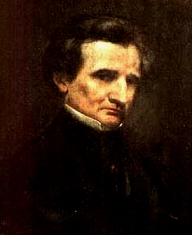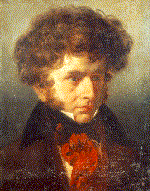|
Xtend
 Listen
Listen
 Period
Period
 Country
Country
 Quotation
Quotation
 Projects
Projects
 Dictionary
Dictionary
 Finders
Finders
|
Born: 11 December
1803, Côte St.-André,
France
Died: 8 March 1869, Paris, France
 Berlioz,
Hector Berlioz,
Hector
Berlioz was groomed, by his father,
to study medicine but he choose to study music instead.
He was ambitious, but the Paris establishment rejected his appeal to get an academic office, obliging him
to make a living as a critic. After a few years in Paris,
Berlioz received the Prix de Rome
establishment rejected his appeal to get an academic office, obliging him
to make a living as a critic. After a few years in Paris,
Berlioz received the Prix de Rome ,
which permitted some time in Rome ,
which permitted some time in Rome at government expense.
at government expense.
 That
same year, he published the Symphonie Fantastique That
same year, he published the Symphonie Fantastique  ,
a musical description of the reveries of a frustrated artist - one of the
most influential programmatic works of the 19th century. With this revolutionary
and original work, he managed to convince the actress Harriet
Smithson ,
a musical description of the reveries of a frustrated artist - one of the
most influential programmatic works of the 19th century. With this revolutionary
and original work, he managed to convince the actress Harriet
Smithson to marry him. The symphony is in five movements, instead of the classical
four and uses the recurrent and short theme (idee
fixe
to marry him. The symphony is in five movements, instead of the classical
four and uses the recurrent and short theme (idee
fixe  ),
which symbolizes the "loved one". ),
which symbolizes the "loved one".
Paganini paid him to write the composition Harold
in Italy
paid him to write the composition Harold
in Italy ,
a symphony ,
a symphony with viola
with viola solo, but it was never performed by the great
violinist.
solo, but it was never performed by the great
violinist.
His Requiem is a good example of Berlioz's remarkable and extravagant orchestration,
with more than 400 instruments and voices, brass bands and massed choirs.
Although the Requiem was well received by the audience and commissioned
by the French
is a good example of Berlioz's remarkable and extravagant orchestration,
with more than 400 instruments and voices, brass bands and massed choirs.
Although the Requiem was well received by the audience and commissioned
by the French government, it didn't compensate for the failures of his operas
government, it didn't compensate for the failures of his operas . .
Berlioz died after a 2 year illness,
and after the deaths of his second wife and his son.
 By
his understanding of individual instruments, and, although he was not a
good player on any instrument (He played Guitar By
his understanding of individual instruments, and, although he was not a
good player on any instrument (He played Guitar relatively good),
Berlioz greatly increased the expressive capabilities of the orchestra.
He was a main figure in the romantic
relatively good),
Berlioz greatly increased the expressive capabilities of the orchestra.
He was a main figure in the romantic era and helped to shape the modern orchestra. Many composers, among them
Liszt
era and helped to shape the modern orchestra. Many composers, among them
Liszt ,
Mahler ,
Mahler ,
Saint-Saens ,
Saint-Saens ,
Richard Strauss ,
Richard Strauss ,
Gounod ,
Gounod ,
and Wagner ,
and Wagner were influenced by his unorthodox musical
structures and meters which helped free them from the restrictive classical
were influenced by his unorthodox musical
structures and meters which helped free them from the restrictive classical forms.
forms.

Berlioz on the WWW
 Sites
Sites
|
 Audio
Audio
|
 Video
Video
|
 Images
Images
|
 MIDI
MIDI
|
|
Description
He played

He Was

and
Music Critic
He Lived in the
 Romantic period
Romantic period
In
 France
France
|